
views
X
Research source
Apart from the tape itself, all you need to get the job done are some basic drywalling supplies, including joint compound and a drywall knife, as well as a little finesse.
Covering Seams Between Drywall Sheets
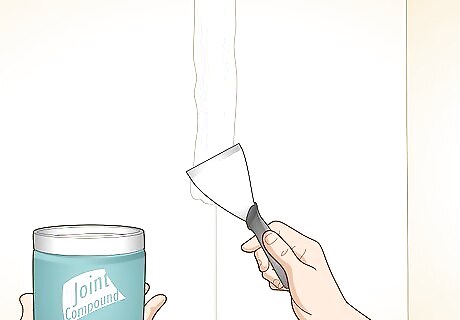
Apply a layer of joint compound on top of the seam you want to tape over. Load the edge of a 5 in (13 cm) drywall knife with about 2 in (5.1 cm) of premixed all-purpose joint compound. Start at 1 end of the seam and press the joint compound into the crack between the drywall sheets. Drag your drywall knife along the entire length of the seam to smooth it out and remove excess compound until there is just a thin layer barely higher than the surface of the drywall.Tip: You can apply this same method to repairing cracks in old or damaged drywall. The concept is the same. Just apply the tape and joint compound to a crack in a drywall sheet instead of a seam between 2 sheets to make quick repairs. Make sure you don’t remove all of the joint compound from the surface as you smooth it out. Joint tape needs a base layer of joint compound to adhere to the drywall. Just try to get rid of lumps and bumps in the joint compound. This method works for any seam where 2 pieces of drywall meet flat on a wall or ceiling, including butt joints and tapered joints. For the unfamiliar, butt joints are where the sides of 2 pieces of drywall butt straight up against one another. Tapered joints are where the sides of 2 pieces of drywall are thinner than the rest of the sheets, and thus create a tapered seam.
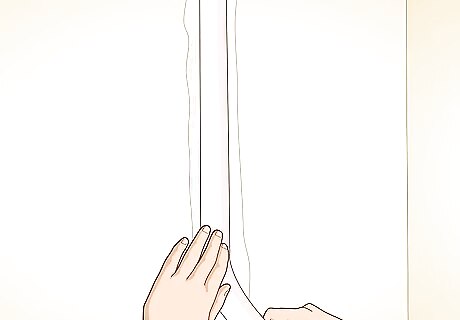
Lay a strip of paper joint tape along the seam on top of the joint compound. Unroll about 3 ft (0.91 m) of joint tape from the roll and center the strip over the seam. Carefully press it down into the joint compound, then unroll the tape along the rest of the seam, pressing it down gently into the compound as you go. Cut or tear the tape when you cover the whole seam. A trick for tearing the tape off the roll is to place the edge of your drywall knife across the face of the tape, then tear it along the straight edge of the knife with your fingers. You'll get a nice clean tear this way.
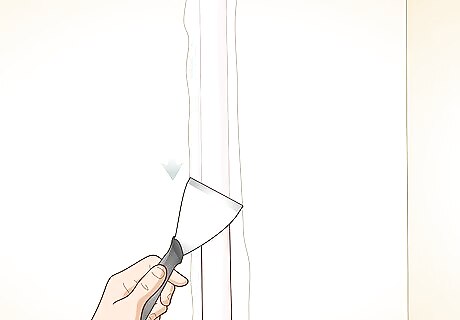
Run your drywall knife along the strip of tape to smooth it out. Start in the middle of the joint and drag your drywall knife to 1 end of the seam in a single smooth stroke. Repeat this for the other half of the seam. Starting in the middle of the seam, rather than at 1 end, will keep you from accidentally peeling the tape off the wall as you smooth it out and press it into the compound.
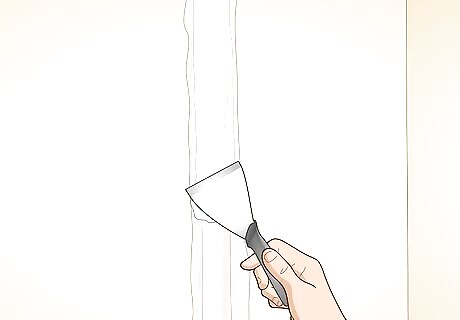
Cover the tape with a thin layer of joint compound and let it dry. Switch to an 8 in (20 cm) drywall knife and load the edge with about 2 in (5.1 cm) of joint compound. Spread it out smoothly over the joint tape, wiping off any extra lumps and bumps of compound so there is just a thin layer on top of the tape that doesn’t stick up noticeably from the drywall. Let everything dry overnight. Switching to a larger drywall knife for this step makes it easier to achieve a smooth, blended finish with the joint compound.
Taping Inside Corners
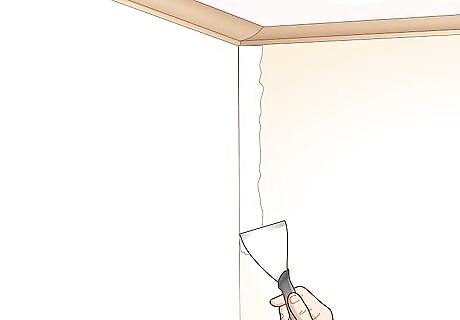
Load joint compound onto 1 corner of a 5 in (13 cm) drywall knife. Put about 2 in (5.1 cm) of premixed all-purpose joint compound onto the left or right side of your drywall knife. This will make it easier to get the joint compound into the corner without making a mess. If you put the joint compound onto the right-hand side of the drywall knife, apply it to the left-hand side of the corner first, and vice versa. Inside corners are the corners where 2 walls meet and form an internal angle.
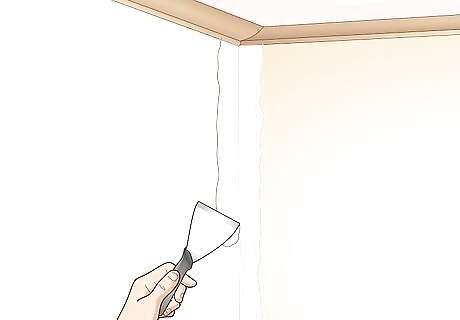
Apply the joint compound to one side of the corner at a time. Start at 1 end of the seam and drag the side of your drywall knife with the joint compound on it along the length of the seam in 1 smooth stroke, almost like you're painting in the corner, so there is a very thin layer that is just barely above the surface of the drywall. Load the other side of your drywall knife with compound and repeat this for the other side of the seam. Try to make this base layer as thin and smooth as possible so you can get the joint tape right into the corner. Aim to get about 2 in (5.1 cm) of joint compound on either side of the corner seam.
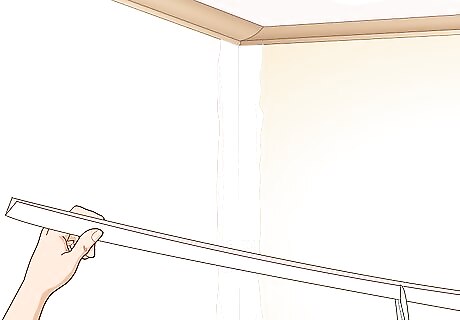
Cut a piece of paper joint tape to length and fold it in half lengthwise. Unroll enough joint tape to cover the seam and cut or tear it off the roll. Fold it in half lengthwise and run your fingers down the whole length of the fold to crease it well. This will make it much easier to fit the tape into the corner with a perfectly even amount of tape on each side of the seam. Note that paper joint tape doesn’t actually have adhesive on it, so it doesn’t matter which way you fold it. The joint compound acts as the adhesive.

Push the tape into an inside corner using the blade of your drywall knife. Fit the creased tape into the corner so the fold is over the seam and gently press it into the joint compound. Use the blade of your drywall knife to carefully push the crease all the way into the inside corner seam. If any excess joint compound oozes out of the sides of the tape as you press it into the corner, scrape it away with your drywall knife and discard it.

Smooth out both sides of the joint tape using your drywall knife. Start at 1 side of the crease and run your drywall knife down the entire length of the tape in one smooth stroke. Repeat this on the other side of the tape. Don’t push too hard or you might pull the tape out of the joint compound. Apply steady, even pressure the whole way along the tape to finesse it into place like a master drywaller.
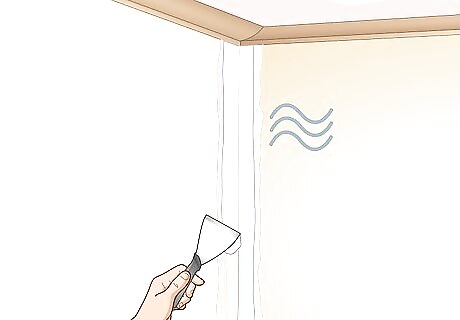
Cover both sides of the joint tape with joint compound and let it dry. Load up your drywall knife with about 2 in (5.1 cm) of joint compound. Smooth it out along 1 side of the corner seam in a single stroke so that it just barely covers the tape and blends in to the surrounding drywall. Repeat this for the other side of the corner seam and let the compound dry overnight. Load up the entire blade of your drywall knife this time, not just half. This will allow you to get a smoother, more blended finish.
Covering Outside Corners
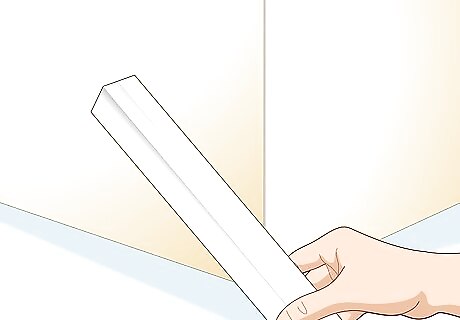
Use paper-faced corner beads to cover outside corners. Corner beads are angled pieces of metal used to cover and protect outside corner joints between 2 sheets of drywall. Paper-faced metal corner beads have pre-applied joint tape on them, which makes it much easier to achieve a smooth, even finish and prevent cracking. Paper-faced corner beads are easier to install than traditional metal corner beads, which you would have to cover with paper anyways. They're super convenient since you only need the same drywall supplies that you use to apply joint tape, unlike traditional corner beads that require you to fasten them in place with drywall screws. Outside corners are the corners where 2 walls meet and form an external angle.

Apply a layer of joint compound to both sides of an outside corner. Load up half of a 5 in (13 cm) drywall knife with premixed all-purpose joint compound. Spread the compound out over 1 side of the outside corner in 1 smooth, even stroke so it just barely covers the drywall. Repeat this for the other side of the outside corner. Try to get about 2 in (5.1 cm) of joint compound on either side of the corner joint.
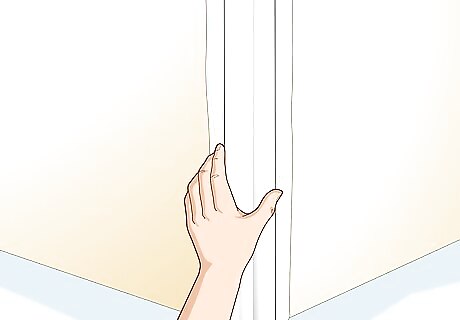
Stick a paper-faced corner bead onto the outside corner joint and let it dry. Position the corner bead over the joint and press it lightly into the joint compound. Check that it is centered over the joint, then use your drywall knife to smooth it out and press it all the way into the joint compound on each side. Leave the corner bead and joint compound to dry overnight.Tip: Use a corner bead that is about ⁄2 in (1.3 cm) shorter than the joint and position it up from the floor. This will prevent any cracks due to structural settling or wall expansion. If there are any gaps or air pockets between the corner bead and the drywall, just lift it up and apply some more joint compound underneath it. Then, use your drywall knife to smooth it back down and squeeze out excess compound. If you need to cut a corner bead to fit, do so with a pair of metal snips.
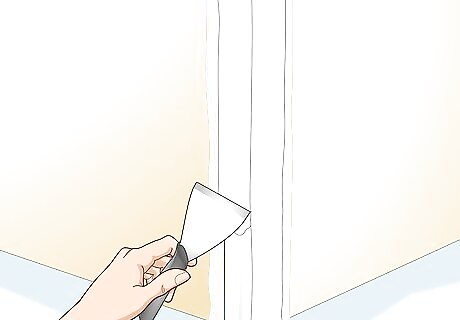
Apply a layer of joint compound to both sides of the corner bead and let it dry. Put about 2 in (5.1 cm) of joint compound on the blade of your drywall knife. Smooth it along 1 side of the paper-faced corner bead so that it covers the paper face and blends in nicely with the surrounding drywall. Repeat this for the other side to wrap up. This step is just like applying joint compound to joint tape on any other kind of seam. Aim to get it as smooth as possible by using long, even strokes. A layer of joint compound about ⁄8 in (0.32 cm) thick is typically enough to cover a paper-faced corner bead and blend it in with the surrounding drywall.



















Comments
0 comment